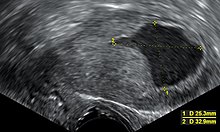Function

The reproductive function of the uterus is to accept a fertilized ovum which passes through the utero-tubal junction from the fallopian tube. The fertilized ovum divides to become a blastocyst, which implants into the endometrium, and derives nourishment from blood vessels which develop exclusively for this purpose. The fertilized ovum becomes an embryo, attaches to a wall of the uterus, creates a placenta, and develops into a fetus (gestates) until childbirth. Due to anatomical barriers such as the pelvis, the uterus is pushed partially into the abdomen due to its expansion during pregnancy. Even during pregnancy the mass of a human uterus amounts to only about a kilogram (2.2 pounds).
The uterus also plays a role in sexual response, by directing blood flow to the pelvis and ovaries, and to the external genitals, including the vagina, labia, and clitoris.
There is also some evidence that the uterus plays a role in cognition in a similar way to the ovaries. A study on rat models found that when the uterus was removed, the rats performed more poorly on spatial memory tasks. Prof. Bimonte-Nelson, the co-author of the study, explained: "the body's autonomic nervous system, which regulates "automated" metabolic processes, such as heart rate, breathing, digestion, and sexual arousal, also has links to the uterus and brain." No similar studies have yet been conducted on humans.
Comments
Post a Comment